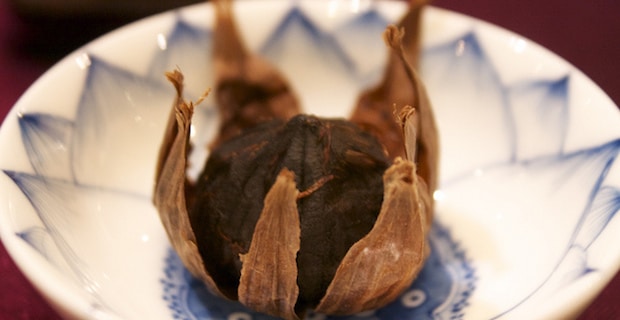
For those of you who are unfamiliar with black garlic, as I was before doing the research for this article, you may share my surprise to learn that there are actually two types of the dark cloven bulbs. Although they have some differences, they do share more than their color: they are both antioxidant rich foods.
Let’s start with the type that starts out as white garlic and then makes a transformation to black. If you believe Taoism mythology, black garlic is an ancient food and eating it will allow you to live forever. Although that idea is romantic, credit for the type of black garlic commonly sought after today is usually bestowed upon Scott Kim, a Korean inventor who first brought the dark cloves to light around 2004.
This type of black garlic is not what happens when you roast garlic and you leave it in the oven too long. Rather, the process involves slowly heating (at 150-180 degrees F) ivory white bulbs of garlic under controlled humidity over a period of several weeks (usually three). (Some sources call this process fermentation while others say it is an aging process. No matter what you call the technique, the end result is the same: black garlic.)
During that time, the amino acids and sugars in garlic conspire to produce melanoidin, the substance that causes the herb to change from white to black. At the same time, the sulfur compound in garlic called allicin changes into s-allylcysteine, which has a number of health-promoting benefits. The garlic is then stored in a clean room for several weeks so it can oxidize.
The changes that occur come with some big health benefits. For example, according to various sources, including registered nutritionist Robert Hobson, who is with the Royal Society of Public Health, the antioxidant levels in black garlic can be as much as twice those found in white garlic. That means black garlic can deliver more immune-enhancing power than its white cousin.
Read more about garlic and cancer
Black garlic is also credited with lowering cholesterol levels (due to its s-allylcysteine content) and blood pressure and fighting cancer. It should be noted that studies of black garlic have been done mostly in lab animals or in cell lines so scientific evidence to support human health benefits is yet to come.
However, there are anecdotal reports of the positive impact of black garlic on cholesterol, triglycerides, and even psoriasis. In addition, the heart-related benefits associated with white garlic and one of its main ingredients, allicin, suggest the same or greater advantages are present in black garlic. Preliminary research in the lab and in animals also suggests the antioxidant powers of black garlic may have a role in improving cognitive abilities in diseases such as Alzheimer’s.
Read about the most antioxidant-rich foods
The “other” black garlic
The other type of black garlic is rare and is found nearly exclusively in the mountains of Korea. While standard white garlic consists of 10 to 12 cloves, this naturally black form has six. It also is the form referred to in Taoist mythology and credited with immortality. Although that idea is grandiose, those who eat this rare garlic will have to settle for the enhanced antioxidant and other health benefits associated with the more common black garlic.
Given the rarity of six-clove black garlic and its reported similarity in health benefits with the more common black garlic, it makes sense to shop for the latter form.
How to enjoy black garlic
Here’s a real bonus when it comes to black garlic: no bad breath. That means you can add black garlic to any dish and still end the meal smelling like a rose, even if you eat it raw. Be prepared for a different culinary experience, however. Black garlic is jelly-like in texture with a hint of balsamic vinegar and is sweeter than white garlic. Feel free to use it as you would white garlic in your recipes, and revel in the different taste experience.
Read more about diagnostic breath tests
Now for the sticker shock: black garlic is expensive. The more common black garlic is available in select supermarkets (e.g., Trader Joe’s), health food stores, and online for about $20 per pound or more. Black garlic is available for sale in single-bulb portions so you can try it before going to the black side in a bigger way!
Image: angelhsu




